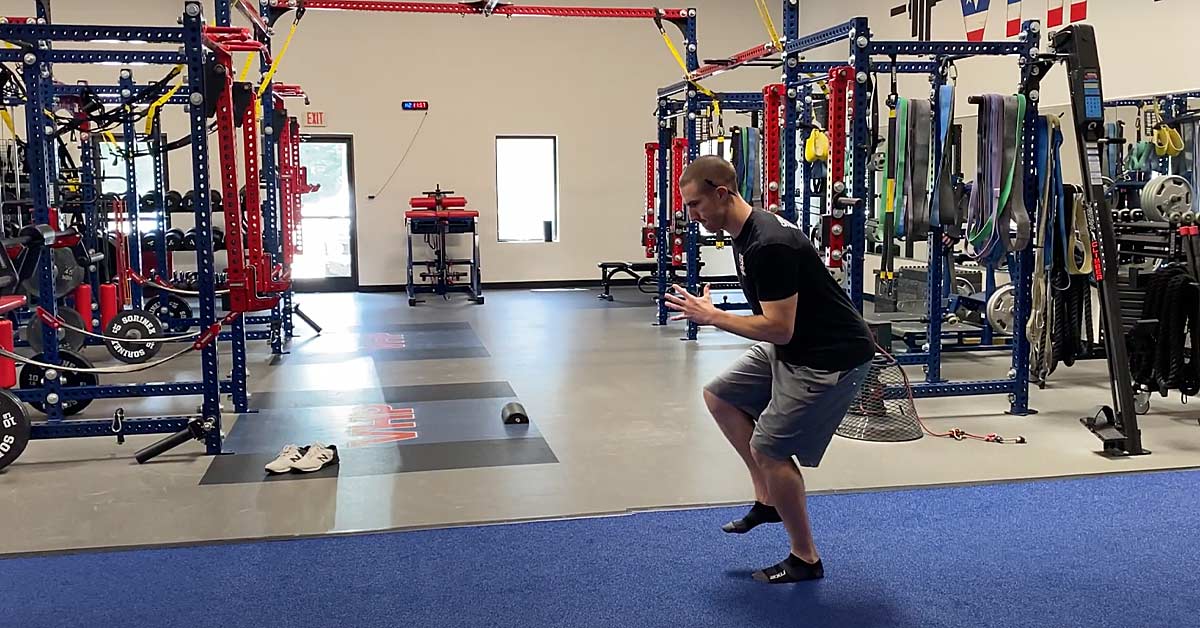As with any specific injury, there are several factors at play with ankle and foot injuries. A few of the more commonly acknowledged factors are footwear, surface type, age/phase of development, speed/direction of applied force, and even environmental conditions, and any of them can be influential.
But what about incomplete or improper training and preparation? Where does this rank among the hierarchy of risk variables for ankle/foot injuries?
But what about incomplete or improper training and preparation? Where does this rank among the hierarchy of risk variables for ankle/foot injuries, asks @danmode_vhp. Share on XDespite our industry becoming zealots of the unwritten doctrine of not being able to “prevent” injury, I would like to continue challenging that thought. While it should clearly go without saying that no measures can totally eradicate the opportunity for injury, I think we have maintained a poor perspective on this concept. For instance, the school of thought where people believe it is negligible or wasteful to directly train the minutia and athletes get what they need from big lifts.
Regarding the foot and ankle, there are several stones left unturned that I believe are in part responsible for the alarming rate of lower-extremity injuries.
Using Research to Guide Exercise Selection
Foot and ankle injuries are problematic across almost all sports, spanning virtually all levels of competition. In fact, in a study examining the rate of lower-extremity injuries in all sports across 100 U.S. high schools, Fernandez et al. reported that ankle injuries accounted for roughly 40% of all lower-extremity injuries in high school athletes (35% of all male injuries, 49.6% of all female injuries).1
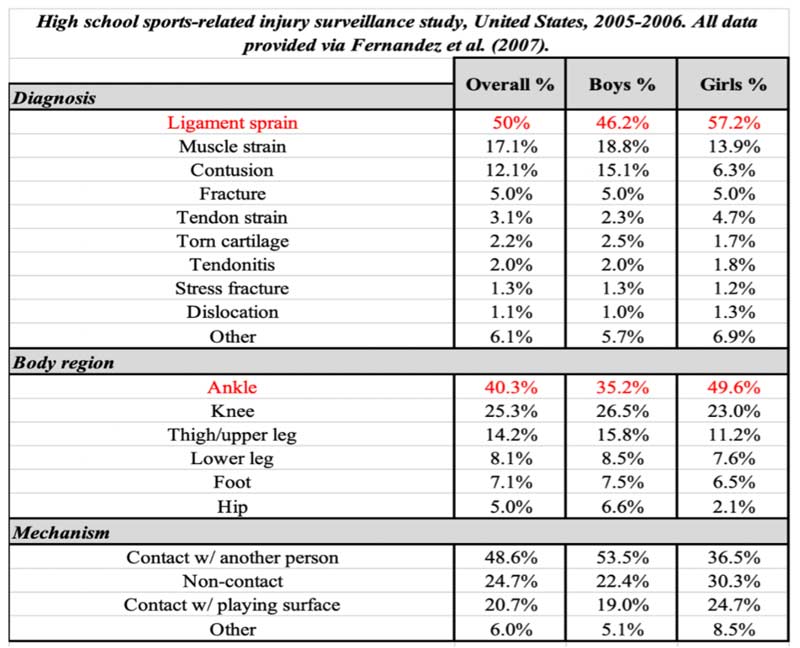
In a separate longitudinal study (2005–2016) examining rates of lower-extremity injuries among high school athletes, Aogaichi et al. reported that across gender-comparable sports (eight total sports), ankle sprains accounted for the most prevalent injury type in 11 of the 16 sports between genders.2
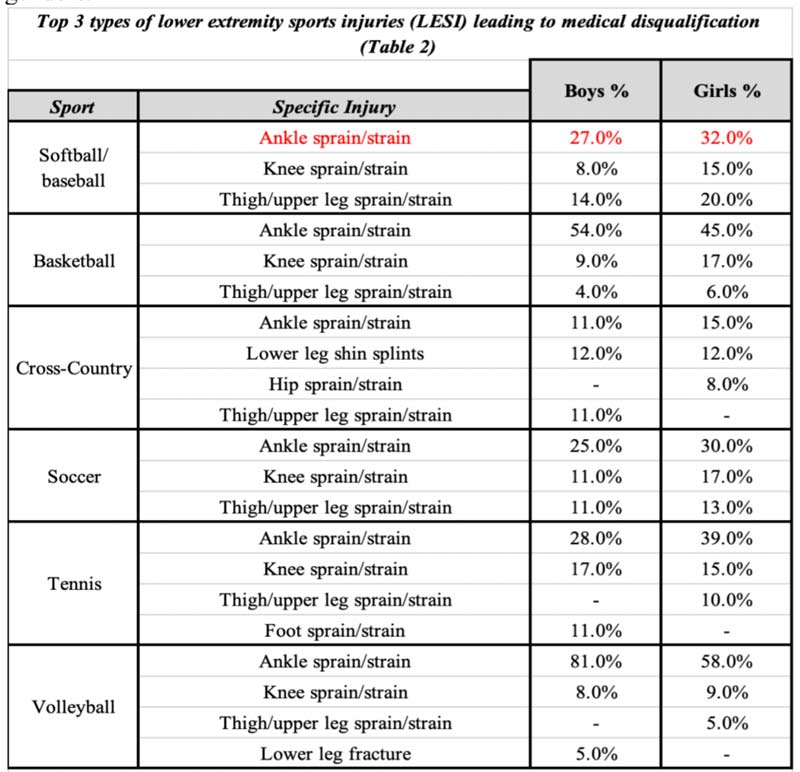
There are some significant observations we can identify at the professional level as well.
In a robust (and fascinating) analytics report examining all injuries in the NFL from 2000–2014, the authors reported that ankle/foot injuries represented roughly 40% of the total lower-extremity injuries reported. We can also infer that lower leg/foot injuries (i.e., ankle/high ankle sprains, Lisfranc fractures, and Achilles injuries) account for some of the longest time to return across all injuries and may be significantly more difficult to come back from.
As I narrow the focus of this article to ankle sprains, I believe it’s important to establish that the rate and severity of ankle sprains are a combination of multiple factors, some of which we may have control over. Among some of the controllable variables, the ones I’ve found the most success with are developing foundational foot strength, including a good bit of barefoot training, addressing lower leg muscles directly, and emphasizing proprioception across exercise selections.
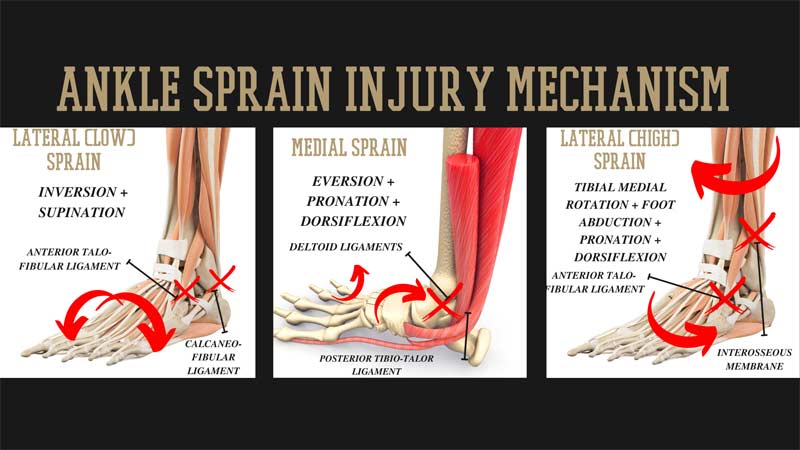
Strengthen the Foot (Eccentrically)
I would venture to say that improving foot eccentric strength and motor control are among the most critical but ignored aspects of sport performance. We must recognize that, irrespective of sport or specific action, almost all human movement starts from interaction with the ground (ground reaction forces—GRF). The simple euphemism for this is poor foundation, weak structure.
I would venture to say that improving foot eccentric strength and motor control are among the most critical but ignored aspects of sport performance, says @danmode_vhp. Share on XBut in a more technical sense, the way I see this is that an inability to load eccentrically through the foot places more undue stress on surrounding structures—which includes the ankle. The longer an athlete goes without addressing the eccentric deficit, the more likely they are to develop common overuse injuries such as turf toe, plantar fasciitis, achilles tendonitis, or chronic ankle sprain development.
Think of eccentric foot control as trying to “widen” or flatten a triangle, where a wider angle equates to more surface area between foot and ground and thus a greater opportunity to disperse force. With a wider foot promoting more evenly distributed forces, athletes are not only capable of producing and tolerating greater force magnitudes, but they are also less likely to have issues with overloading or overstressing specific regions of the foot.
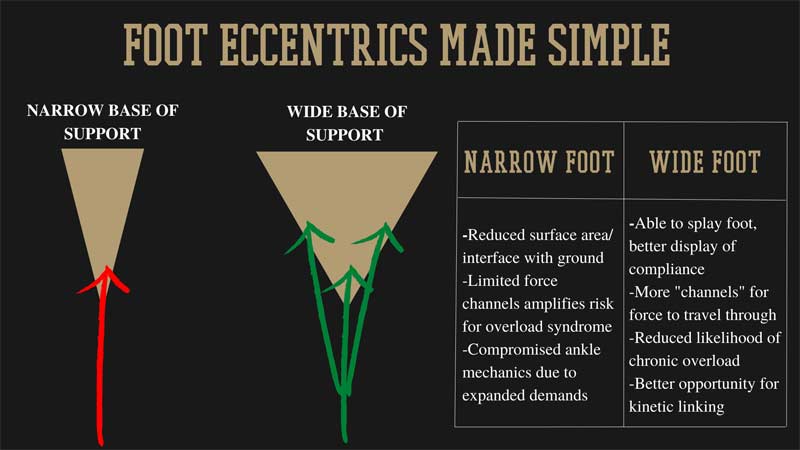
As this relates to chronic ankle sprains, limited eccentric foot tolerance means that the ankle will experience greater amounts of torque when accommodating GRFs. Because the foot is incapable of splaying, the base becomes narrower. This means the ankle is now required to do two things at once:
- Control excess range of motion due to the lack of stability at the foot.
- Work as more of a terminal stabilizer for the knee.
This is a fundamental recipe for disaster, and if unaddressed, it can become a significant vulnerability for the ankle joint.
Improving eccentric foot control starts with the intrinsic muscles of the foot. The intrinsic foot muscles include the lumbricals, plantar aponeuroses, foot ab/adductors, and foot flexors/extensors. The beauty is there are several things you can do that require minimum thought, without having to adjust your programming dramatically. The best way to start is by simply having your athletes get out of their shoes for portions of their training.
Training barefoot doesn’t need to be an all-or-nothing endeavor. Some portions of training are appropriate for barefoot training. For instance, whereas high force/dynamic primary lifts (i.e., squats/cleans/etc.) may be an imprudent time for barefoot work, warm-up/movement prep options, accessory blocks, and select low-level plyos are all good opportunities to get athletes out of their shoes. Removing their shoes allows athletes to have a true interface with the ground. This promotes an opportunity to emphasize foot compliance, which requires the foot to detect and mold itself to the external environment.
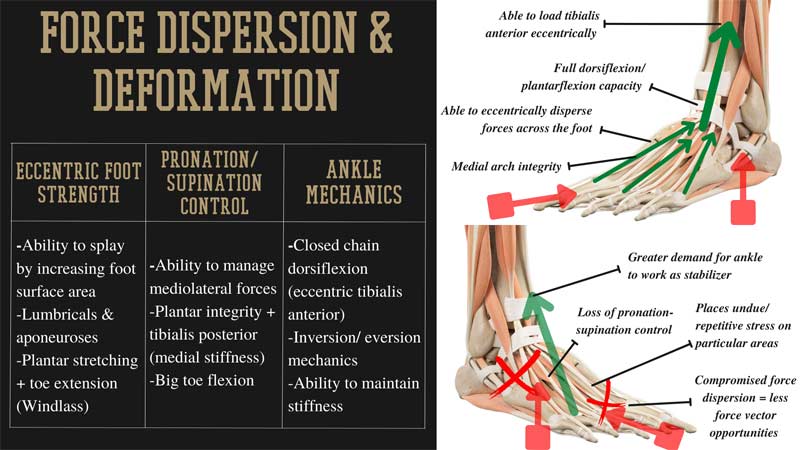
Another simple strategy is to have them perform more movements in reverse. Even just backward walking/marching can be effective for novice athletes or early-phase return to play (RTP). Reverse locomotion promotes a reciprocated foot patterning, and, given that forward walking/running involves almost exclusively concentric/isometric actions, this reverse pattern is a novel way to introduce eccentrics.
Another simple strategy to strengthen the foot is to have athletes perform more movements in reverse. This reverse pattern is a novel way to introduce eccentrics, says @danmode_vhp. Share on XThis is a concept Pete Bommaritto and his back dorsiflexion series first introduced me to, and it is remarkably simple yet effective for loading the foot/ankle complex eccentrically. And with this series, we get the added element of some velocity/change of direction along with eccentric loading.
Strengthen the Mediolateral Structures
Examining the mechanism of injury for ankle sprains, irrespective of type, should clearly show the significance of medial and lateral lower leg structures. The peroneal group, which spans the lateral compartment of the lower leg, plays an essential role in stabilizing the ankle/foot complex. The peroneals are criminally overlooked in training and are one of the primary components with high ankle sprains.
An even less discussed muscle, the tibialis posterior, spans the medial aspect of the foot and runs up the medial compartment of the lower leg. The tibialis posterior primarily plantarflexes and inverts the foot and is also critical for providing midfoot stability.
When the tibialis posterior is not functioning properly, athletes can become more susceptible to medial/eversion ankle sprains, as there is greater deviation between the ankle joint and foot actions with reduced medial border foot stability. The opposing muscle, the tibialis anterior (TA), also plays a critical role in supporting and stabilizing the ankle. The TA is a primary dorsiflexor while assisting in foot inversion, but an overlooked role of the TA is acting to eccentrically stabilize the tibia during rapid plantarflexion. This is key with regard to how ankle sprains occur.
While the muscles of the lower leg are primarily responsible for the extrinsic support of the foot/ankle complex, the arches of the foot play a major role as stabilizers and providing intrinsic support for mediolateral control. Moreover, the dense ligamentous bed (retinaculum) that envelops the ankle/foot junction is also critical for stability and support.
Addressing the stiffness and spring functions of the arches is essential for bulletproofing the ankle, and this goes for both acute and chronic conditions, says @danmode_vhp. Share on XIn addition to providing structure and durability to the foot, the arches also collectively disperse and generate force across the plantar surface of the foot. Having disproportionate force capabilities between medial and lateral longitudinal arches can create non-functional foot biasing that will likely destabilize both the foot and ankle. Addressing the stiffness and spring functions of the arches is essential for bulletproofing the ankle, and this goes for both acute and chronic conditions.
Sensory and Motor Functions
I mentioned above that the ankle is supported primarily by robust ligaments and a dense network of connective tissues enveloping the joint. These connective tissues are enriched with sensory and motor receptors we know as proprioceptors (fascia/tendons/muscles) and mechanoreceptors (ligaments). So, in addition to the stability and structure these fibrous tissues provide, they are also essential for things like balance, motor control, sensory function, and neuromuscular function. It’s imperative to recognize that these receptors are not stimulated (at least not significantly) during conventional bilateral movements with limited mechanical deviations. Moreover, there is a reduced proprioceptive demand as familiarity to certain movements/exercises increases.
There are two specific points where I look to emphasize proprioception and motor control for ankle sprains:
- Relatively early in the RTP timeline.
- Toward the end of reintegrating into sport.
Speaking to the former, the early phase applications will consist mostly of simple, controlled, and rudimentary types of drills. For instance, band-assisted pogo hops (using a foam pad), band offset hops, and hop hop sticks are all low-level drills that can be used as precursors to re-strengthening the area. The goal with early phase applications is to stimulate the area, but in a controlled and predictive way. The athlete knows what’s coming and can plan and orient accordingly.
You can use additional tools to mitigate the force impact with these drills as well. Using bands to unload mass or having the athlete work from foam pads helps to diminish the effects of force on the joint.
The addition of cognitive elements provides a substantial factor of challenging the athlete to trust the joint…exposure to reactionary movements is fundamental for successful RTP, says @danmode_vhp. Share on XIn the late phase applications, once strength and capacity have been established, we want to look toward drills that are more reactive and unplanned in nature. This addition of a cognitive element (perceive/react/respond) provides a substantial factor of challenging the athlete to trust the joint. As we know, a lingering consequence of ankle sprains is the fear of re-spraining the joint. Despite being fully healed mechanically, athletes often struggle to fully regain confidence in the joint, which continues to compromise play and function. This outlines why the athlete being exposed to reactionary/challenging movements is fundamental for successful RTP.
Take-Home Points
Ankle sprains are an inevitable component of sport and believing we can entirely prevent any injury is foolish. However, there is often a lot more we can do to make our athletes more robust to injury, and this is especially true for the foot/ankle. Common denominators for ankle sprains include poor foot function/strength (namely eccentric), excessive ankle joint laxity, poor foot compliance, and impaired sensory-motor function.
Additionally, the kinetic integration and complementary functioning of the foot, ankle, and lower leg working in tandem is a leading priority for minimizing the likelihood of recurring ankle sprains. We can check every individual box there is, but if the collective pieces are never challenged in concert, we are doing our athletes a disservice. (See here for 28 restorative exercises for ankle sprains.)
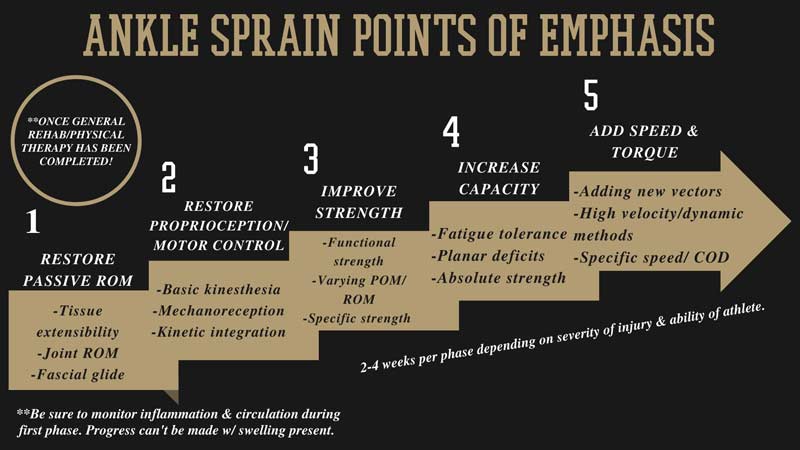
Don’t become infatuated by dressed-up mobility drills. While the ankle is a mobile joint, creating a great disparity between mobility and stability functions can destabilize the joint, compromising functional stiffness and force capabilities.
Lastly, don’t ignore the sensory-motor elements of ankle and foot function. This is the piece that will tie everything together by giving the athlete a better sense of trust and confidence in the joint.
Since you’re here…
…we have a small favor to ask. More people are reading SimpliFaster than ever, and each week we bring you compelling content from coaches, sport scientists, and physiotherapists who are devoted to building better athletes. Please take a moment to share the articles on social media, engage the authors with questions and comments below, and link to articles when appropriate if you have a blog or participate on forums of related topics. — SF
References
1. Fernandez WG, Yard EE, and Comstock, RD. “Epidemiology of lower extremity injuries among US high school athletes.” Academic Emergency Medicine. 2007;14(7):641–645.
2. Aogaichi Brant J, Johnson B, Brou L, Comstock D, and Vu, T. “Rates and Patterns of Lower Extremity Sports Injuries in All Gender-Comparable US High School Sports.” Orthopaedic Journal of Sports Medicine. 2019;7(10): 232596711987305.
Since you’re here…
…we have a small favor to ask. More people are reading SimpliFaster than ever, and each week we bring you compelling content from coaches, sport scientists, and physiotherapists who are devoted to building better athletes. Please take a moment to share the articles on social media, engage the authors with questions and comments below, and link to articles when appropriate if you have a blog or participate on forums of related topics. — SF

